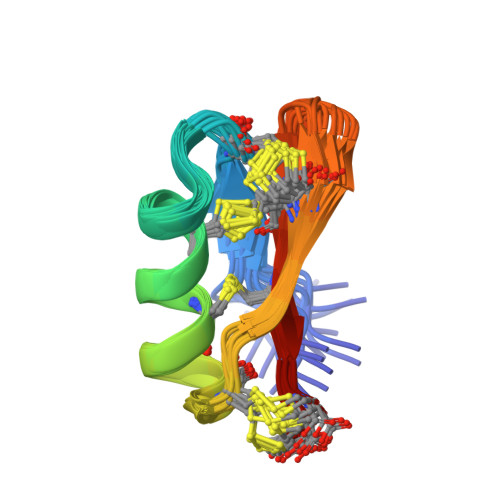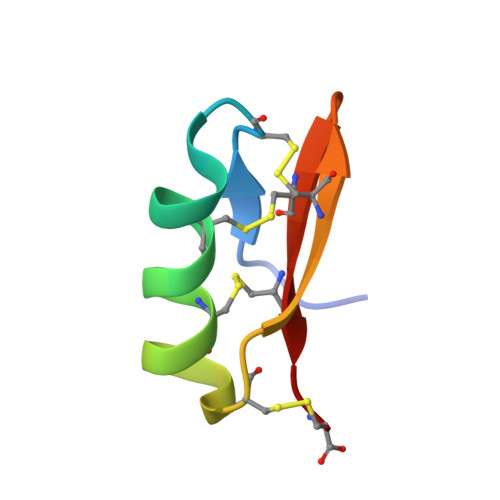Chemical synthesis and 1H-NMR 3D structure determination of AgTx2-MTX chimera, a new potential blocker for Kv1.2 channel, derived from MTX and AgTx2 scorpion toxins.
Pimentel, C., M'Barek, S., Visan, V., Grissmer, S., Sampieri, F., Sabatier, J.M., Darbon, H., Fajloun, Z.(2008) Protein Sci 17: 107-118
- PubMed: 18042681
- DOI: https://doi.org/10.1110/ps.073122908
- Primary Citation of Related Structures:
2Z3S - PubMed Abstract:
Agitoxin 2 (AgTx2) is a 38-residue scorpion toxin, cross-linked by three disulfide bridges, which acts on voltage-gated K(+) (Kv) channels. Maurotoxin (MTX) is a 34-residue scorpion toxin with an uncommon four-disulfide bridge reticulation, acting on both Ca(2+)-activated and Kv channels. A 39-mer chimeric peptide, named AgTx2-MTX, was designed from the sequence of the two toxins and chemically synthesized. It encompasses residues 1-5 of AgTx2, followed by the complete sequence of MTX. As established by enzyme cleavage, the new AgTx2-MTX molecule displays half-cystine pairings of the type C1-C5, C2-C6, C3-C7, and C4-C8, which is different from that of MTX. The 3D structure of AgTx2-MTX solved by (1)H-NMR, revealed both alpha-helical and beta-sheet structures, consistent with a common alpha/beta scaffold of scorpion toxins. Pharmacological assays of AgTx2-MTX revealed that this new molecule is more potent than both original toxins in blocking rat Kv1.2 channel. Docking simulations, performed with the 3D structure of AgTx2-MTX, confirmed this result and demonstrated the participation of the N-terminal domain of AgTx2 in its increased affinity for Kv1.2 through additional molecular contacts. Altogether, the data indicated that replacement of the N-terminal domain of MTX by the one of AgTx2 in the AgTx2-MTX chimera results in a reorganization of the disulfide bridge arrangement and an increase of affinity to the Kv1.2 channel.
Organizational Affiliation:
Architecture et fonction des Macromolecules Biologiques, Centre National de la Recherche Scientifique, 13288 Marseille Cedex 09, France.
















